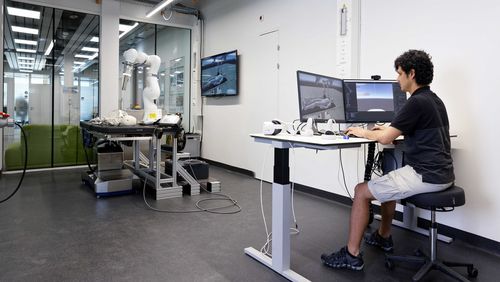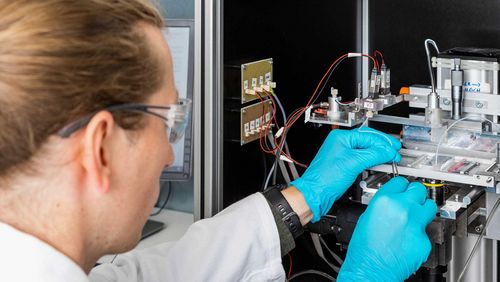Ultrasound to activate protein splitting
Researchers in the TriggerINK project in Aachen are studying how a supportive scaffold made of hydrogel ink can be used to stimulate damaged cartilage into regrowing. They’ve now developed a key piece of the puzzle: a biochemical system that enables hydrogels to become harder or more flexible, as needed—and to be moulded into new shapes.
People with osteoarthritis know from bitter experience that damaged cartilage can no longer heal on its own. The result is often chronic pain that worsens over time. This could change, thanks to the TriggerINK project, which receives financing from the Werner Siemens Foundation. Indeed, researchers at DWI – Leibniz Institute for Interactive Materials in Aachen, Germany, are working on a visionary method to promote cartilage regeneration.
The main feature of their innovative concept is the development of a hydrogel that a 3D printer robot injects directly into damaged cartilage. A hydrogel—or a bio-ink—is a gelatinous substance consisting mainly of water and, to a lesser proportion, of a biocompatible polymer. In the Aachen project, the team’s bio-ink forms a type of scaffold along which the body’s own cartilage tissue can regrow. And the hydrogel is enriched with components that respond to external signals such as heat, vibration or sound in such a way that they promote cell growth.
Now, the researchers in the group led by Andreas Herrmann, scientific director at DWI, have developed a method that will aid in effecting targeted changes in the bio-ink’s properties; for this, they created a new, sophisticated biochemical mechanism. A study conducted in collaboration with a research team from China was recently published in the peer-reviewed journal Nature Communications.

An enzyme and its inhibitor
The starting point for the study was a hydrogel scaffold to which researchers attached two different proteins—thrombin and hirudin—via chemical bonding. Thrombin is a blood coagulation factor and an enzyme that cleaves the protein fibrinogen into the “glue” fibrin inside the body. Hirudin is an anticoagulant and a thrombin inhibitor. This means as long as hirudin and thrombin are bonded together, thrombin is unable to split proteins into the thickening “glue”.
The researchers genetically engineered the hirudin and thrombin so that they insert themselves precisely into predefined positions in the hydrogel scaffold, where they then bond. If the scaffold is pulled apart, the external force causes the thrombin-hirudin bond to break. This in turn activates the thrombin enzyme, which can be utilised to change the hydrogel’s properties.
From this system, the researchers developed two methods for bringing about such changes. First, the aim is to harden an originally soft hydrogel. “For this, we integrated fibrinogen—also a coagulation factor—into our system,” Andreas Herrmann explains. “Now, when thrombin is activated, it splits fibrinogen into fibrin fibres that reinforce the hydrogel—and the bio-ink scaffold stiffens.”
By contrast, the second method is designed to make stiff hydrogel more flexible. For this, the researchers added molecular chains to their system that crosslink the hydrogel scaffold, thereby strengthening it. When mechanical force is used to activate the thrombin, the enzyme also splits these crosslinks, and a stiff bio-ink becomes softer.

b Schematic illustration of the mechanismof the regulation of the mechanical properties of hydrogel through controlled biocatalysis. A substrate that can be activated by thrombin to self-assemble into a second network is added to the hydrogel, resulting in the self-stiffening behavior of the polymer networks. Alternatively, a self-softening hydrogel can be obtained when a thrombin-cleavable crosslinker is introduced.
The power of ultrasound
But how will the researchers manage to pull apart a hydrogel scaffold located inside the human body to break the bond between the thrombin enzyme and its inhibitor hirudin—and thus activate the enzyme? Andreas Herrmann says the answer is ultrasound: “The ultrasound frequency causes very small vesicles (fluid-filled sacs) to form in the body. When they collapse, this can exert a force on the hydrogel. For the first time, our system demonstrates that a mechanical force applied directly at the molecular level can be used to switch on an enzyme.”
And there’s more. The study also demonstrates that through the cautious, cyclical application of tensile loading, it’s already possible to adjust the mechanical properties of the hydrogel with very high precision. Herrmann says this process is simple to regulate: “As soon as we stop the tensile tests, the thrombin and hirudin bond again—the enzyme is deactivated, and the hydrogel remains in its new state.”
In a further step, the researchers applied the method to produce hydrogels with complex shapes. Here, they placed two hydrogel layers—one with self-stiffening, the other with self-softening properties—on top of each other and bonded them together. When activated, one layer contracts while the other expands, leading to a bending in the bilayer hydrogel. Because the researchers arranged the layers so precisely, various shapes formed, including some that look like four-petalled flowers.
New ideas for the TriggerINK project
Andreas Herrmann believes that, in future, this shape-morphing capability could be used in the field of regenerative medicine. One possibility is to introduce an implant into the body via an endoscope—and then utilise mechanical activation to bring it into the desired shape. And in the TriggerINK project itself, these types of materials could enable growth factors to be activated using ultrasound. “Or,” Herrmann adds, “we could even apply ultrasound to dissolve the hydrogel with the aim of inducing the cells to migrate to the polymer matrix.”
Before they achieve their ambitious goals, however, the researchers must overcome several hurdles. One concern is the enzyme thrombin at the heart of the current system: although it’s an important coagulation mechanism for closing wounds, it also poses dangers inside the body. If blood clots block blood vessels, there’s a risk of thromboses, pulmonary embolisms and strokes. “That’s why we need to replace thrombin with another protein-cleaving enzyme,” Andreas Herrmann says.



